By Jonathan Klopp
I want all large buildings to have
wind and solar generation. Homes with the best sunlight should have rooftop
solar. I want vertical farming skyscrapers. I want wide scale urban composting.
I want robust filters on all exhaust points. We need islands of fertility
(communal forests/orchards acting as urban lungs) in every neighborhood. We
need to sustainably and locally source most municipal supplies. We need to
incorporate new building materials (like hempcrete). We need buildings to have
net negative emissions, whether they produce more clean energy or sequester
more emissions than used to construct or power them. The hard part is finding a
use for everything's waste, including ours.
These mostly just require
investment. The park in every neighborhood? Relatively easy. A change to how
waste is treated? Mostly just need to develop facilities at scale. Vertical
farming already exists on a smaller scale, we already have CSA's and community
gardens, and industries already have filtration regulations and standards. We
already are making more bike lanes in a lot of cities, and large buildings with
solar and wind have already been built in Dubai. There's sticker-thin
technology developed by a Polish firm that can be placed on the back of your
phone to charge it from any light source (i.e. solar or lamp). Hempcrete is
already being utilized in some smaller buildings. In other words, I am for Deep
Green cities.
As you might be able to tell, when
talking about climate change, I have usually focused on cities and industry.
They are massive sources of pollution and inefficiency, after all. They are
also highly visible targets for improvement, but there is more to the equation
beyond emissions and efficiency: reforestation and sequestration.
A broad
spectrum of green, peaks resting in mists, intermittent rains (despite it being
the dry season), and rusty red dirt roads were the first sights to greet us as
we pulled off the paved roads and into the rural Mata Atlantica. Minas Gerais,
Brazil is a state rich in natural resources, and the exploitation of these
resources led to the founding of several of its oldest cities. The extraction did not stop with metals and
minerals; it continued on in the farming practices advocated by the different
levels of government. Today we see monocrops of coffee, and other commodity
crops that have been deemed profitable, depleting exposed soils. Only 2% of the
primary forests in the state remain. Regular rains washed away top soils, and
slowly those rains are becoming less regular.
There are
bright spots where farmers are trying to address these issues. They are slowly
growing into ‘islands of fertility’, as one agro-ecologist described his method
for growing multiple types of plants together to bolster the bioavailability of
nutrients for particular cultivars. At Iracambi, we sat with Robin Le Breton as
he discussed forest corridors that help the soils retain water, awaken
 dormant
springs, and improve the soil quality. Successes have been achieved on a small
scale, farmer by farmer. As we see livelihoods in Minas Gerais recuperating it
strikes me that maybe this is what we need: islands of fertility scattered
amongst the mountains, connected by forest corridors and riddled with the
plurality of the available biodiversity. Transforming how we interact with the
environment is a big task, but starting small could be the answer.
dormant
springs, and improve the soil quality. Successes have been achieved on a small
scale, farmer by farmer. As we see livelihoods in Minas Gerais recuperating it
strikes me that maybe this is what we need: islands of fertility scattered
amongst the mountains, connected by forest corridors and riddled with the
plurality of the available biodiversity. Transforming how we interact with the
environment is a big task, but starting small could be the answer.
Maybe the path to greener urban communities can be found
through treating our cities like ecosystems.

No comments:
Post a Comment